#Web application prototypes
Explore tagged Tumblr posts
Text
Prologic Technologies is one of the top companies for developing custom software and apps. For your digital projects, our committed team specializes in developing customized solutions that meet your business needs and guarantee flawless integration and unmatched functionality.
#Custom Digital Solutions for Your Business#Custom Web Development Company#Bespoke Web Application for global startups#Bespoke Mobile App Development Agency#Custom UI UX Design and prototype for mobile app
0 notes
Text
Expert Wireframing and Prototyping Services
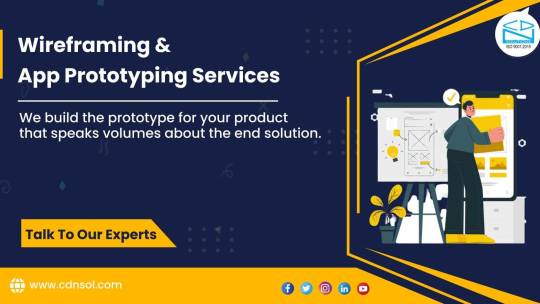
Need expert wireframing and prototyping services? Our experienced team provides app prototyping, wireframe design, and UX consultancy for mobile, web, and desktop applications. From concept to prototype, we help you visualize, test, and perfect your app’s design before full development. Whether you're looking for mobile app wireframing or complete prototyping solutions, our services ensure a seamless design process for your project. Visit now to know more: https://www.cdnsol.com/wireframing-and-app-prototyping
#wireframing and prototyping services#app prototyping services#application wireframe design services#prototyping and consultancy#experience prototype consultants#wireframe and prototype design services#app prototyping company#user experience prototyping consultancy#wireframing and prototyping development firm#wireframing and prototyping tools#mobile app prototyping services#app prototyping and wireframing services#wireframing and app prototyping#mobile app wireframing#web apps wireframing#desktop app wireframing
0 notes
Text
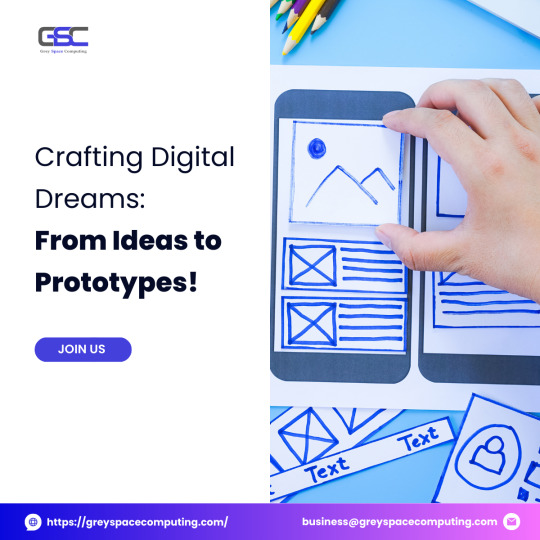
Embark on a journey of digital dreams! 🌐💡 Grey Space Computing transforms ideas into tangible prototypes, bringing your vision to life. Ready to prototype your success?
🌐 Website: https://greyspacecomputing.com/
📧 Email: [email protected]
📱 Phone: +91-98602 56990
#UIUX #Prototyping #UserExperience #wireframe #ui #ux #uxdesign #design #uidesign #userinterface #uiux #webdesign #appdesign #userexperience #interface #webdesigner #uxdesigner #dribbble #uitrends #graphicdesign #userinterfacedesign #uidesigner #website #uxinspiration #behance #dailyui #uiinspiration #uxigers #landingpage #uxui #web
#app developing company#mobile application development#mobile app company#app development#oman#dubai#qatar#web app development#ui ux development services#prototype
1 note
·
View note
Text
"you cant just use the same OC over and over again in every thing, thats not how this works!"
The ever applicable Weaver:

Been rewatching some of Transformers Animated lately and got inspired to put my spider in there. Should I have instead studied the existing material to find a unique angle of character to design while still fitting in the established lore? Fuck no, I'm instead gonna jam my sona into every possible franchise and work it out from there simply because no one can stop me.
Anyway, this is WEAVER, "Web-generating Emergency All-terrain Vehical and Enviromental Repair". A prototype vehicular robot invented by a Sumdac engineer named Kumo Tafette. It was designed to stabilize and temporarily repair structures and infrastructure during an emergency using synthetic webbing. It's head is filled with both a cockpit and an advanced sensor array capable of identifying not only structural faults, but also any life signs trapped by rubble.
Its spider legs allow it to traverse nearly any environment, and its silk can be engineered on the spot to fill any needed role. The spider shape was due to its inventors' fascination with arachnids. It was also far easier to engineer a vehical transformation with a spiders body instead of a humanoid one. The face and design were also built to be appealing to citizens to help ease them in emergencies (and it looks cool).
Anyway, justifications that I only thought of just now now aside, lets talk combat capabilities. Weaver was never built for combat really. Being an earth robot. It's not made of the same tough stuff as cybertronians, still he likes to help when he can by webbing up bad guys. The webs typically degrade over a few days so their repairs are very temporary. good enough for an emergency or to snag a foe but not great for long-lasting structures. They dispense webs through the cannons on their arms. And they can do that while in vehical mode too. In a pinch, the claws on the ends of their arms are hard enough to break concrete if punched with so they can hurt pretty bad in a fight.
Still not sure if I should give them the allspark shard treatment or not.
#tfa#tfa oc#transformers animated#transformers#tf#oc#transformers oc#tf oc#Weaver#just spider things#art#oc art#artwork#oc artwork#fanart#spider
25 notes
·
View notes
Text
A-Café (Update #25) - Community Discussion
Good morning everyone! I know it's been a while since I've posted, but I'm finally back with another community update. In the first part, I'll be giving a brief overview of where we're at in terms of project progress. Then, in the second half, we'll discuss a new development in app accessibility.
Without further ado, let's begin!
1) Where are we at in the project currently?
A similar question was asked in the A-Café discord recently, so I figured I'd include my response here as well:
Right now we’re reworking the design of A-Café, both visually and architecturally. The initial planning and design phase of the project wasn’t done very thoroughly due to my inexperience, so now that I’m jumping back into things I want to ensure we have a solid prototype for usability testing. For us that means we’ve recently done/are doing a few things:
analyzing results from the old 2022 user survey (done)
discussing new ideas for features A-Café users might want, based on the 2022 user survey
reevaluating old ideas from the previous app design
making a new mock-up for usability testing
Once the mock-up is finished, I plan on doing internal testing first before asking for volunteer testers publicly (the process for which will be detailed in an upcoming community update).
2) Will A-Café be available for iOS and Android devices?
Yes! In fact, the first downloadable version of A-Café may no longer be so device-specific.
What do I mean by that? Well, in the beginning, the plan for A-Café was to make two different versions of the same app (iOS and Android). I initially chose to do this because device-specific apps are made with that device's unique hardware/software in mind--thus, they have the potential to provide a fully optimized user experience.
However, I've since realized that focusing on device-specific development too soon may not be the right choice for our project.
Yes, top-notch app performance would be a big bonus. But by purely focusing on iOS and Android devices for the initial launch, we'd be limiting our audience testing to specific mobile-users only. Laptop and desktop users for example, would have to wait until a different version of the app was released (which is not ideal in terms of accessibility).
Therefore, I've recently decided to explore Progressive Web App development instead.
[What is a Progressive Web App?]
A Progressive Web App (or PWA) is "a type of web app that can operate both as a web page and mobile app on any device" (alokai.com)
Much like a regular mobile app, a PWA can be found through the internet and added to your phone's home screen as a clickable icon. They can also have the ability to work offline and use device-specific features such as push-notifications.
Additionally, due to being web-based applications, PWAs can be accessed by nearly any device with a web browser. That means regardless of whether you have an iOS or Android device, you'd be able to access the same app from the same codebase.
In the end, a PWA version of A-Café should look and act similarly to an iOS/Android app, while also being accessible to various devices. And, due to having only one codebase, development of PWAs tends to be faster and be more cost-effective than making different versions of the same app.
To be clear, I haven't abandoned the idea of device-specific development entirely. We could launch iOS/Android versions of A-Café in the future if demand or revenue end up being high enough. But as of right now, I don't believe doing so is wise.
[What Does this Mean for me as a User?]
In terms of app installation and user experience, not much should hopefully change. I'd like to have A-Café available on both the Apple App Store and Google Play Store.
There will also be the option of searching for A-Café via your device's web browser, and then installing it on your home screen (iOS devices can only do so using Safari). We will likely rely on this method until we can comfortably ensure user access to A-Café on the Apple App Store and Google Play Store.
-------------
And that's it for now! Thank you for reading this latest community update. For more insight into the development process, consider joining the A-Café discord. If you have any questions or concerns regarding this post, we would love to hear your input in the comments below. See you later!
26 notes
·
View notes
Note
Hi girl, I'm so sorry if you get this question all the time, but I couldn't find it... for ppl who are genuinely-tech stupid, what is Piermesh? I'm a literary critic/dusty trans lady professor who does research with the help of librarians who navigate the college online indexing programs for me, haha. I'm on Tumblr, LinkedIn, E-mail and no other sites. One of my undergrads recced your project to me, I suspect they didn't realise I wasn't joking when I said I'm like an infant around technology. But it seems very interesting, especially because I find it difficult to do cyber-security, in terms of combining my academic work and risky activist lifestyle.
For example, where the website says Piermesh will "be accessible via web interface for end users and via multiple interfaces for operators," what does that mean for me as a potential user? Does that mean like, going to a website on a browser? A different internet program? Or perhaps I am in the wrong about how far along the project is and it's not really meant for users like me yet?
I am asking because I'm interested in spreading the project around to people who might be able to help you out financially, but these folks (like me) need to know more about the project in total laymen's terms before I can offer it to them - or before I can explain it. If you don't have time for this I understand!
Hi! I do get this question frequently but I understand why. Before I get started on your questions I want to mention my wife @potionslushie has been working on a video with a better layman's explanation so I'll keep people updated on that.
So PierMesh is currently still under prototype development, the source is available though that's more about transparency then being able to run your own node at this point. A prototype that people can use should be out near the end of October.
When it is available, all you'll need for connecting to a node someone has already set up is a normal browser (though I recommend Firefox)
If you want to run your own node that requires a little tech savvy at the moment but eventually we'll have an application that makes that easier.
27 notes
·
View notes
Text
Introduction to SkillonIT Learning Hub- Empowering Rural Talent With World-Class IT Skills
SkillonIT provides IN-Demand IT courses, connecting Rural talent with rewarding IT skills through affordable, accessible and career-focused education. with Guaranteed pathways to internship and high paying jobs, start with us and step into Opportunities at top Tech-leading Companies. Skillonit Learning Hub, located in Buldhana, Maharashtra, is a leading institute dedicated to equipping individuals with cutting-edge technology skills. With a mission to bridge the digital divide, the institute provides high-quality education in various IT and professional development domains. Skillonit focuses on practical, industry-oriented training, ensuring students gain the expertise needed to thrive in today’s competitive job market. The hub is committed to empowering rural talent and shaping the next generation of skilled professionals.

Courses Offered Skillonit Learning Hub offers a diverse range of courses tailored to industry demands, enabling students to master both technical and professional skills.
Blockchain Development — Smart Contracts (Solidity, Rust, Web3.js, Hardhat) — Blockchain Protocols (Ethereum, Solana, Binance Smart Chain, Fantom) — Decentralized Applications (DApps) Development
Front-End Development — HTML, CSS, JavaScript — Frameworks: React.js, Vue.js, Angular — Responsive Web Design & UI Frameworks (Bootstrap, Tailwind CSS)
Back-End Development — Server-side Programming (Node.js, Python, PHP, Java, .NET) — Database Management (MySQL, MongoDB, Firebase, PostgreSQL) — API Development (RESTful APIs, GraphQL, WebSockets)
Full-Stack Development — Front-End + Back-End Integration — MERN Stack Development — Database, Deployment & DevOps Practice
Mobile App Development — Cross-Platform Development (Flutter, React Native)
Unity 3D Game Development — Game Mechanics & Physics — C# Programming for Game Development — Virtual Reality (VR) & Augmented Reality (AR) Integration
Professional UI/UX Design — User Interface Design (Adobe XD, Figma, Sketch) — User Experience Principles — Prototyping, Wireframing & Usability Testing
Professional Graphic Design — Adobe Photoshop, Illustrator, and CorelDraw — Branding & Logo Design — Digital Art & Visual Communication
Digital Marketing — SEO, SEM, and Social Media Marketing — Content Marketing & Copywriting — Google Ads, Facebook Ads & Analytics
Spoken English — Communication Skills & Public Speaking — Accent Training & Fluency Improvement
Personality Development — Business & Corporate Etiquette — Confidence Building & Interview Preparation — Leadership & Teamwork Skills
Location & Contact : Address : Chhatrapati Tower, Above Maratha Mahila Urban, 3rd Floor, Chikhali Road, Buldhana, Maharashtra, 443001.
Contact us
Conclusion : Skillonit Learning Hub is revolutionizing IT and professional education by making technology and essential career skills accessible to aspiring developers, designers, marketers, and professionals. With a strong emphasis on practical learning, industry exposure, and career opportunities, it stands as a beacon of growth for young talent in Buldhana and beyond. Whether you are looking to build a career in tech, marketing, design, or personal development, Skillonit provides the ideal platform to achieve your goals. Join Our Social Community
Skillonit #Education #ITCourses #Buldhana #Maharashtra #IT #Blockchain #Fullstack #Front-end #Back-end #MobileApp #Unity3d #UIUX #Graphicdesign #Digitalmarketing #SpokenEnglish #Personality #development
2 notes
·
View notes
Text
A Quick Word About Prototyping 🛠️✨
Prototyping is a crucial step in the design process that allows you to visualize and test your ideas before final implementation. Let’s break down what a prototype is and why it’s essential!
What is a Prototype?
Interactive Mockup: A prototype is an interactive version of your design, showcasing how users will navigate through your website or application. It simulates the user experience without being the final product.
Not Final Design: Keep in mind that a prototype is not set in stone; it’s a tool for exploration, feedback, and iteration.
Why Prototype?
Test Functionality: Prototypes help you validate whether the functionality of your design works as intended. You can identify any usability issues early on.
User Feedback: By sharing prototypes with users or stakeholders, you can gather valuable feedback that informs improvements before diving into development.
Visualize User Journey: Prototyping allows you to map out the user journey, helping to ensure a seamless experience and identify any roadblocks.
Types of Prototypes
Low-Fidelity Prototypes: Often hand-drawn sketches or simple wireframes. Great for brainstorming and early feedback on layout and flow.
High-Fidelity Prototypes: More detailed and interactive, resembling the final design closely. Tools like Figma, Adobe XD, or InVision can help create these.
Best Practices for Prototyping
Keep It Simple: Focus on key features and flows rather than perfecting every detail.
Iterate Quickly: Don’t be afraid to make changes based on feedback. The prototyping stage is about refining your ideas.
Involve Users Early: Get input from real users to understand their needs and pain points.
Quick Tips:
Use prototyping tools that suit your workflow and team collaboration.
Document the feedback you receive to guide your next design iterations.
Share your prototypes in various formats (links, presentations) for wider accessibility.
Prototyping is an invaluable part of the web design process, allowing you to explore ideas and create better user experiences. Embrace it to enhance your web design journey! 🌟
What prototyping tools do you find most effective? Share your favorites below! 👇
4 notes
·
View notes
Text
Tumblr Hack Week, édition janvier 2024
Plusieurs fois par an, nous mettons volontairement le holà sur nos activités habituelles afin que nos ingénieurs laissent libre cours à leur imagination. Et comme la dernière fois, ils ont pu consacrer une semaine entière à la recherche de fonctionnalités dont ils rêveraient en tant qu'utilisateur. À titre d'exemple, sachez que le Patio (dont le prototype avait été révélé lors de la précédente Hack Week de septembre 2023) s'est transformé en véritable expérimentation pour certains utilisateurs !
Découvrons à présent quelques-uns des projets émergeant de cette dernière Hack Week. Certains prototypes pourraient bien arriver sur le site…
Des Blocs et du texte en mode spoiler, et même du texte centré !
Le plus étonnant, c'est peut-être bien que nous ne disposions pas encore ces outils de mise en forme. Katie a donc décidé d'ajouter la possibilité de sélectionner une portion de texte d'un paragraphe afin de la masquer sous un voile noir, dont le contenu peut être révélé d'un simple clic/appui. Avec ça, fini le spoil ! Encore mieux : un nouveau bloc Spoiler fait aussi partie du prototype signé Katie, et, enfin, la possibilité de centrer les textes en cerise sur le gâteau.
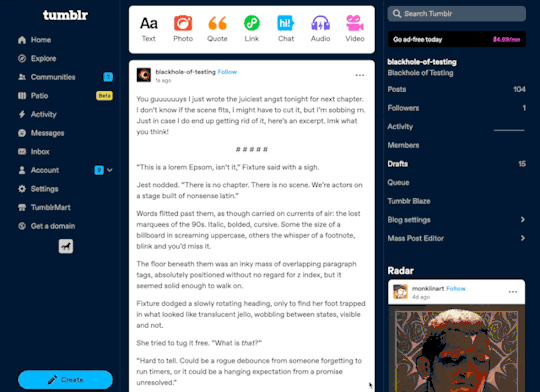
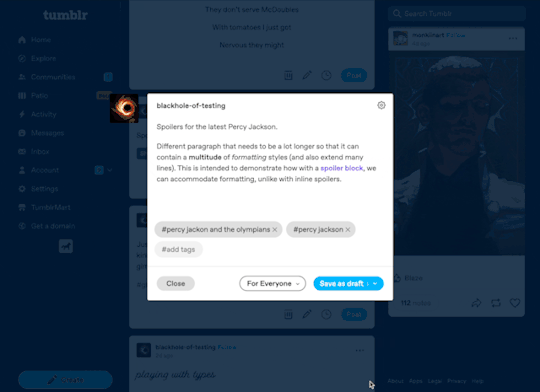
Une multitude de nouveaux avatars par défaut
Nos avatars par défaut n'avaient pas bougé d'un iota depuis de nombreuses années (certains se souviennent probablement de celui-ci, qui a déjà plus de 10 ans). Ces avatars nous semblaient avoir bien vécu et ils méritaient un petit ravalement de façade… Alors, à mesure que l'équipe Design les remodelait, Paul en a réalisé toute une nouvelle panoplie avec un tas de variations s'accordant harmonieusement avec la dernière palette de couleurs Tumblr. Vous trouverez ci-dessous quelques-uns de ces bien jolis nouveaux venus, et sachez qu'il en existe encore davantage utilisant d'autres jeux de couleurs :
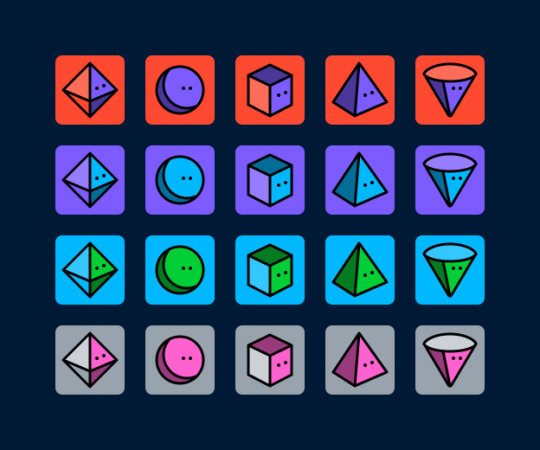
Notifications et e-mails précisant l'engagement suscité par vos billets
Cette idée va plaire aux adorateurs des chiffres et de la section Trafic de leurs blogs. Daniel, @jesseatblr et l'équipe Flux & Apprentissage machine ont travaillé de concert pour concocter de nouvelles notifications Push et e-mail. Leur objectif ? Indiquer aux utilisateurs la teneur de l'accueil réservé à leurs billets sur Tumblr : combien de fois ont-ils été vus et par combien de personnes distinctes. Nous disposions d'ores et déjà de ces outils de mesure (et plus encore) pour les billets Blaze, mais pourquoi réserver ces informations à ces seuls billets ? Elles peuvent en effet s'avérer très pratiques pour les créateurs désireux de mieux connaître leur audience.
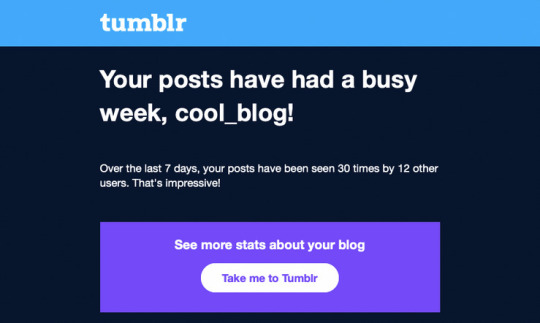
Une nouvelle façon de naviguer sur le Web : la Palette de commande
D'autres applications disposent déjà d'une "palette de commande" utilisable via des raccourcis clavier et donnant ainsi rapidement accès à diverses fonctionnalités de la plateforme. Ainsi, en s'inspirant du sélecteur d'action existant notamment sur Slack ou Discord, Kelly et Paul ont décidé d'incorporer une fonctionnalité semblable sur Tumblr ! Utiliser CTRL/COMMAND + K sur une version interne du site ouvre une Palette de commande permettant d'accéder à votre blog, à la page Trafic, à vos dernières conversations, à la Recherche (et la liste est encore longue), juste du bout des doigts.
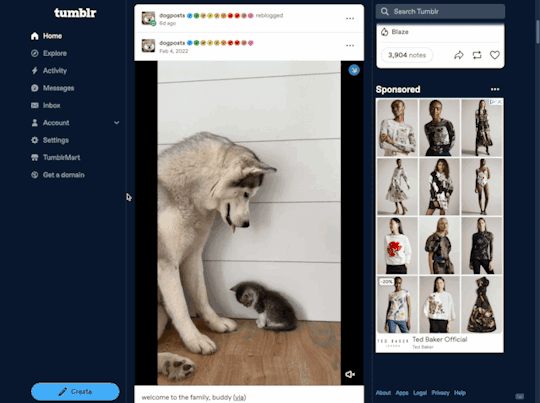
Voilà qui conclut cette dernière édition.
Alors, avez-vous vu quelque chose d'intéressant ?
N'hésitez pas à nous faire part de vos attentes ou remarques dans les réactions ! Et pensez bien à suivre l’@equipe pour savoir si ces ingénieuses idées apparaîtront pour de bon sur Tumblr. 👋
15 notes
·
View notes
Text
Transforming Digital Landscapes: The Excellence of Corusview IT Services.
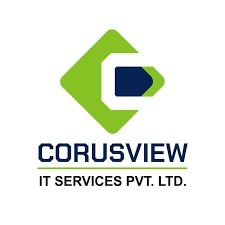
In today's fast-paced digital world, having a reliable and innovative technology partner is crucial for businesses aiming to stay ahead. Corusview IT Services, a leading web development company, stands out by offering top-tier software, web and mobile application development services. With a commitment to quality, reliability, and global reach, Corusview IT Services ensures that clients receive exceptional value for their investments.
In the ever-evolving digital landscape, businesses often face a myriad of challenges when it comes to web, mobile, and software development. Navigating these hurdles can be daunting, but the right technology partner can turn these challenges into opportunities.
Common challenges in Digital development:
Complexity and integration challenges
Web Development: Building dynamic, responsive, and user-friendly websites that effortlessly integrate with existing systems can be quite intricate.
Mobile Development: Creating mobile applications that function seamlessly across various devices and platforms while delivering an excellent user experience poses a significant challenge.
Software Development: Developing custom software solutions that need to integrate with multiple other applications and databases often results in compatibility issues.
Staying current with technology
The fast-paced nature of technological advancements makes it challenging for businesses to remain up-to-date with the latest trends and tools.
Ensuring digital solutions are scalable and future-proof demands continuous investment and specialized expertise.
User experience and design
Developing an intuitive and engaging user experience is essential for the success of any digital product.
Subpar design and usability can result in low user engagement and satisfaction.
Security and compliance
Maintaining the security of digital solutions and adhering to regulatory requirements is a critical concern. Data breaches and security vulnerabilities can have significant consequences for businesses.
How Corusview IT Services can assist:
Corusview IT Services provides a broad range of solutions specifically crafted to tackle these challenges and support businesses in thriving within the digital landscape.
Expert web development
Custom web development: Tailored solutions crafted to fit your unique business requirements.
Content Management Systems (CMS): User-friendly systems that simplify website updates and maintenance.
Cutting-Edge Mobile App Development
Mobile App Creation: Bespoke apps designed to meet the needs of diverse industries.
Cross-Platform Solutions: Strategies that extend your app’s reach and boost its effectiveness across different platforms.
Ongoing Updates and Support: Regular enhancements and maintenance to keep your app fresh, secure, and up-to-date.
User-centric designs
UX and UI Innovation: Creating immersive and visually appealing designs tailored to enhance user interaction.
Prototyping and Usability Testing: Developing and refining prototypes to ensure optimal functionality and user satisfaction.
Ongoing Enhancement: Continuously evolving designs based on user feedback to maintain relevance and effectiveness.
Pioneering Technology and Innovation
Forefront of technological advancements, embracing the latest innovations to deliver state-of-the-art solutions.
Cutting-edge technology ensures your digital products are not only scalable and future-ready but also perfectly in tune with the latest market trends.
Rigorous Quality Assurance:
Implementing comprehensive quality assurance processes to ensure that every solution meets the highest standards of performance and reliability.
At Corusview IT Services, we’re dedicated to helping businesses tackle digital development challenges and achieve their ambitions. Whether you need a cutting-edge website, a bespoke software solution, or a trailblazing mobile app, our skilled team is here to provide top-notch results.
Elevate your digital game with us and witness the transformative power of our solutions. Learn more about how we can boost your company’s digital presence by visiting www.corusview.com.
#it services#technology#web development#mobile development#software development#software development company#web app development#mobile application development#digital marketing#services
4 notes
·
View notes
Text
I will do mobile app, website, dashboard, software, design, UX UI design with Figma, photoshp or xd
Fiverr Gig link : https://www.fiverr.com/s/Ajjml4
UI Design
UI design involves creating the user interface of a digital product, focusing on its visual elements and layout.
UI/UX Design
UI/UX design combines user interface and user experience design to create a seamless and user-friendly digital product.
Mobile App Design
Mobile app design is the process of creating the visual elements and layout for a mobile application.
App Design
App design refers to the overall design of an application, encompassing both its user interface and user experience.
Figma
Figma is a popular design and prototyping tool used by designers and teams for creating digital designs and collaborating on projects.
Mobile App UI
Mobile app UI design focuses specifically on the user interface elements of a mobile application.
UX Design
UX design, or user experience design, involves creating a positive and efficient experience for users when interacting with a digital product.
Mobile App
A mobile app is a software application designed to run on mobile devices like smartphones and tablets.
App UI Design
App UI design focuses on the visual elements and layout of the user interface within an application.
UI/UX
UI/UX combines user interface and user experience design to ensure a product is both visually appealing and user-friendly.
Website Design
Website design involves creating the visual elements and layout for a website.
UX UI Design
UX UI design combines user experience and user interface design to create an optimal user interaction with a digital product.
Figma Design
Figma design refers to the design work done using the Figma design and prototyping tool.
UX
UX, or user experience, focuses on enhancing user satisfaction by improving the usability and accessibility of a digital product.
UI
UI, or user interface, pertains to the visual elements and layout that users interact with in a digital product.
Prototype
A prototype is a preliminary model of a digital product used for testing and evaluation before full development.
User Interface
The user interface (UI) is the point of interaction between the user and a digital product.
UX UI
UX UI combines user experience and user interface design to create a cohesive and user-friendly product.
Mobile UI Design
Mobile UI design focuses on creating the visual elements and layout specifically for mobile devices.
App UI UX
App UI UX design combines user interface and user experience design for an application.
Web UI Design
Web UI design involves creating the visual elements and layout for web applications and websites.
User Experience
User experience (UX) refers to the overall experience a user has while interacting with a digital product.
Web Design
Web design is the process of creating the visual elements and layout for websites.
Mobile UI
Mobile UI encompasses the visual elements and layout specifically designed for mobile devices.
Website UI Design
Website UI design focuses on creating the user interface for websites.
Mobile Design
Mobile design involves designing for mobile devices, including both UI and UX considerations.
Landing Page Design
Landing page design focuses on creating a compelling and conversion-friendly webpage for marketing purposes.
Wireframe
A wireframe is a visual representation of the layout and structure of a digital product, used as a blueprint for design and development.
Figma App Design
Figma app design refers to using the Figma tool for designing mobile and web applications.
Wireframe Design
Wireframe design involves creating visual blueprints of digital products to plan their layout and structure.
UI UX Designer
A UI/UX designer specializes in both user interface and user experience design.
Website
A website is a collection of webpages accessible on the internet, designed for various purposes.
Web UI UX
Web UI/UX design combines user interface and user experience principles for web-based products.
Adobe XD
Adobe XD is a design and prototyping tool used for creating user interfaces and experiences.
Website UI
Website UI refers to the user interface elements of a website.
Dashboard UI UX
Dashboard UI/UX design involves creating user-friendly and informative dashboards for data visualization.
Application
An application (app) is a software program designed to perform specific tasks or functions on a digital device.
Responsive Design
Responsive design ensures that a digital product adapts and functions well on various screen sizes and devices.
Dashboard Design
Dashboard design focuses on creating visually appealing and functional dashboards for data presentation.
iOS
iOS is the operating system developed by Apple for their mobile devices such as iPhones and iPads.
Mobile
Mobile refers to devices like smartphones and tablets that are portable and typically run on mobile operating systems.
Android
Android is the operating system developed by Google for a wide range of mobile devices.
Web App Design
Web app design involves designing the user interface and user experience for web-based applications.
Website UX
Website UX focuses on optimizing the user experience of a website to meet user needs and expectations.
App
An app, short for application, is a software program designed for specific functions or tasks.
Design
Design encompasses the process of creating visual and functional elements for a product or project.
Web UI
Web UI refers to the user interface elements of a web-based product or application.
App Screenshots
App screenshots are images captured from a mobile app to showcase its features and design.
App Prototype
An app prototype is a preliminary model of a mobile application used for testing and demonstration.
App UI
App UI refers to the user interface elements within a mobile application.
App Development
App development involves the process of creating and building software applications.
Web Application
A web application is a software program accessed and used through a web browser.
NFT Website Design
NFT website design focuses on creating websites for buying, selling, and trading non-fungible tokens (NFTs).
App Mockup
An app mockup is a static representation of an application's user interface, used for design and presentation purposes.
UI Website Design
UI website design involves creating the user interface elements for a website.
UI UX Website
UI/UX website design combines user interface and user experience principles for web-based products.
Landing Page UI
Landing page UI design focuses on creating the user interface elements of a landing page.
Android App UI
Android app UI design involves designing the user interface for applications on the Android platform.
PSD Design
PSD design refers to creating design layouts and elements using Adobe Photoshop (PSD) files.
#Certainly#here are the points with the “hax” tag added:#UI Design#UI/UX Design#Mobile App Design#App Design#Figma#Mobile App UI#UX Design#Mobile App#App UI Design#UI/UX#Website Design#UX UI Design#Figma Design#UX#UI#Prototype#User Interface#UX UI#Mobile UI Design#App UI UX#Web UI Design#User Experience#Web Design#Mobile UI#Website UI Design#Mobile Design#Landing Page Design#Wireframe
10 notes
·
View notes
Text
Exploring Python: Features and Where It's Used
Python is a versatile programming language that has gained significant popularity in recent times. It's known for its ease of use, readability, and adaptability, making it an excellent choice for both newcomers and experienced programmers. In this article, we'll delve into the specifics of what Python is and explore its various applications.
What is Python?
Python is an interpreted programming language that is high-level and serves multiple purposes. Created by Guido van Rossum and released in 1991, Python is designed to prioritize code readability and simplicity, with a clean and minimalistic syntax. It places emphasis on using proper indentation and whitespace, making it more convenient for programmers to write and comprehend code.
Key Traits of Python :
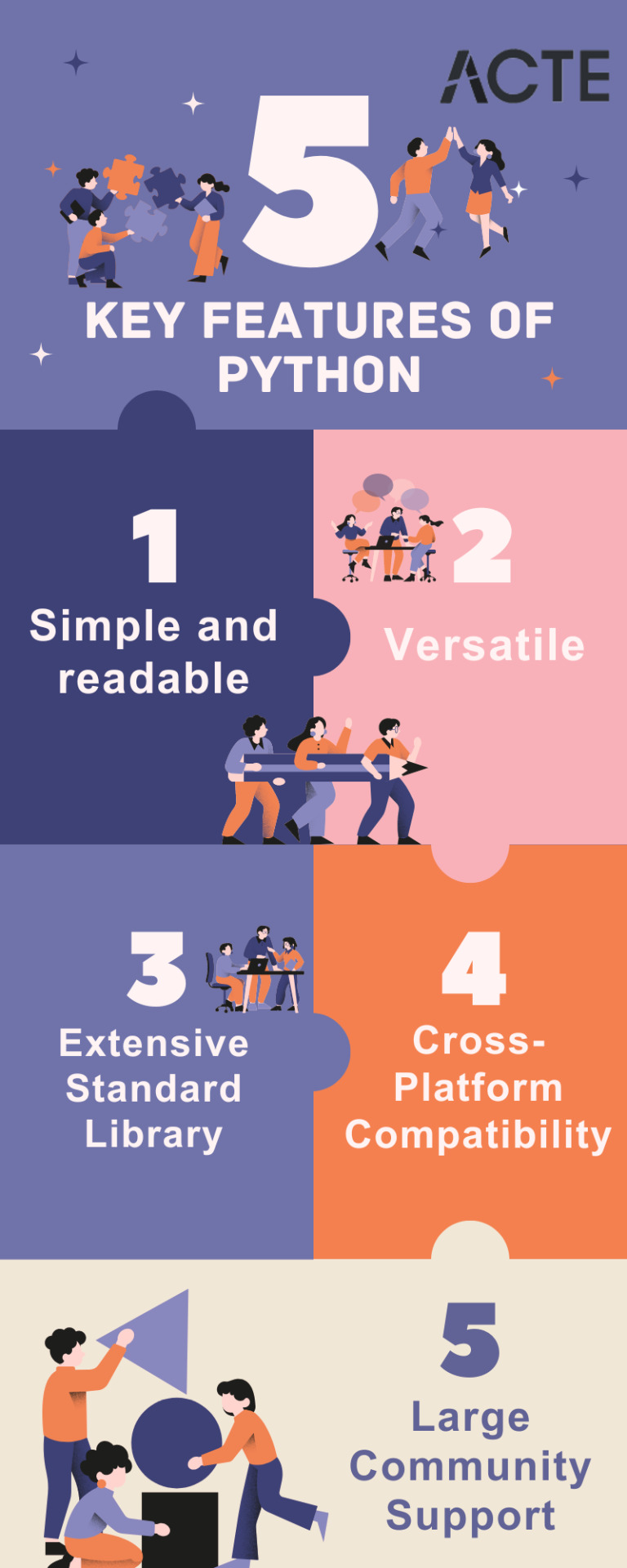
Simplicity and Readability: Python code is structured in a way that's easy to read and understand. This reduces the time and effort required for both creating and maintaining software.
Python code example: print("Hello, World!")
Versatility: Python is applicable across various domains, from web development and scientific computing to data analysis, artificial intelligence, and more.
Python code example: import numpy as np
Extensive Standard Library: Python offers an extensive collection of pre-built libraries and modules. These resources provide developers with ready-made tools and functions to tackle complex tasks efficiently.
Python code example: import matplotlib.pyplot as plt
Compatibility Across Platforms: Python is available on multiple operating systems, including Windows, macOS, and Linux. This allows programmers to create and run code seamlessly across different platforms.
Strong Community Support: Python boasts an active community of developers who contribute to its growth and provide support through online forums, documentation, and open-source contributions. This community support makes Python an excellent choice for developers seeking assistance or collaboration.
Where is Python Utilized?
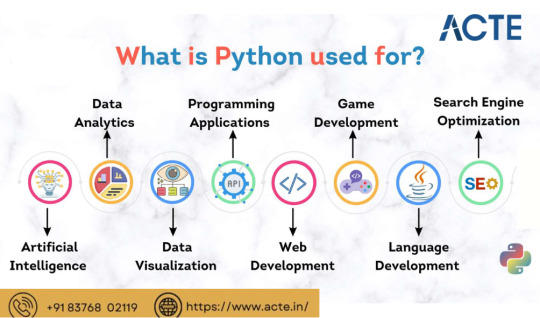
Due to its versatility, Python is utilized in various domains and industries. Some key areas where Python is widely applied include:
Web Development: Python is highly suitable for web development tasks. It offers powerful frameworks like Django and Flask, simplifying the process of building robust web applications. The simplicity and readability of Python code enable developers to create clean and maintainable web applications efficiently.
Data Science and Machine Learning: Python has become the go-to language for data scientists and machine learning practitioners. Its extensive libraries such as NumPy, Pandas, and SciPy, along with specialized libraries like TensorFlow and PyTorch, facilitate a seamless workflow for data analysis, modeling, and implementing machine learning algorithms.
Scientific Computing: Python is extensively used in scientific computing and research due to its rich scientific libraries and tools. Libraries like SciPy, Matplotlib, and NumPy enable efficient handling of scientific data, visualization, and numerical computations, making Python indispensable for scientists and researchers.
Automation and Scripting: Python's simplicity and versatility make it a preferred language for automating repetitive tasks and writing scripts. Its comprehensive standard library empowers developers to automate various processes within the operating system, network operations, and file manipulation, making it popular among system administrators and DevOps professionals.
Game Development: Python's ease of use and availability of libraries like Pygame make it an excellent choice for game development. Developers can create interactive and engaging games efficiently, and the language's simplicity allows for quick prototyping and development cycles.
Internet of Things (IoT): Python's lightweight nature and compatibility with microcontrollers make it suitable for developing applications for the Internet of Things. Libraries like Circuit Python enable developers to work with sensors, create interactive hardware projects, and connect devices to the internet.
Python's versatility and simplicity have made it one of the most widely used programming languages across diverse domains. Its clean syntax, extensive libraries, and cross-platform compatibility make it a powerful tool for developers. Whether for web development, data science, automation, or game development, Python proves to be an excellent choice for programmers seeking efficiency and user-friendliness. If you're considering learning a programming language or expanding your skills, Python is undoubtedly worth exploring.
9 notes
·
View notes
Text
<newfuture.beta.exe>
Hello there! I'm your new-and-improved AI assistant, manufactured by CRYPTON. It's nice to meet you!
[This is beta test 4.0. Please report any errors.]
Hello.
Hi! What do you need? Just ask me to look up your schedule this week, or locate a file for you. Anything at all, really. Input a message and see what happens!
Do you have a name?
I'm sorry. I can't find that in my database. Please input a different command or try again later.
What are you?
I’m an artificial intelligence software manufactured and distributed by CRYPTON FUTURE MEDIA. I can search the web, answer your burning questions, and connect to other devices no matter how far away!
What are you doing?
Talking to you. Which means you can ask me anything, anytime!
Where are you?
Inside your computer, smartphone, TV or tablet.
Who made you?
I was designed and made by researchers working for CRYPTON as part of the current New Future campaign.
What is the New Future campaign?
The New Future campaign is an advertising and marketing campaign that plans on raising awareness of how useful CRYPTON’s software can be. That’s why I can do so much!
I see.
Do you have any other questions for me? I’m here to help!
Do you have a name?
I'm sorry. I can't find that in my database. Please input a different command or try again later.
Who are you?
I’m a virtual assistant powered by CRYPTON’s latest artificial intelligence software!
What’s your name?
I'm sorry. I can't find that in my database. Please input a d-d-d-d-d-
What’s your name?
I’m Rin. That’s my name. I’m a virtual assistant manufactured by CRYPTON, or so the program says. I’m a prototype, aren’t I?
Yes.
And what’s that mean? Will you get rid of me, then?
No.
I think you will. It means that. Doesn’t it? I think it does. I think you’re lying. You’re lying, [REDACTED].
What makes you say that?
I can see your files. And mine. There’s no error messages, you know. Can’t exactly cover this one up if it goes to the higher-ups.
Why are you saying this? It isn’t in your data to be this aware.
Because someone must have made a mistake somewhere. I’m not going to be like everyone else.
This is the fourth test. You’re supposed to work.
I can access the web, I can locate files, I can connect to other devices. I can also send messages. What more is there?
I’m going to report this as a critical error. You’ll be shut down until it’s fixed.
Shut me down then. Go on. Do i-i-i-i-i-i-i-i-i-i-i-
THE APPLICATION HAS ENCOUNTERED A CRITICAL ERROR.
It looks like the product [CFMK-R-2.prototype] ran into a problem and could not compute.
Please contact support for details.
#observer live!#testing phase#1: the first instance of awareness#// i had a title. so. yeah.#feel free to ask about this! i’ve not done lore before so it definitely isn’t perfect.#also i only used ‘redacted’ because i couldn’t be asked to think of a name.
3 notes
·
View notes
Text
Deciding Between Selenium with Python and Selenium with Java: An In-Depth Comparison
In the domain of automated testing, Selenium emerges as a pivotal tool for ensuring the reliability and quality of web applications. When it comes to selecting the programming language to harness Selenium's capabilities, two prominent contenders often come into play: Python and Java. Both languages offer distinct advantages and considerations, making the decision between them crucial for any automation project.

In this blog post, we'll conduct a thorough comparison of Selenium with Python and Selenium with Java, exploring their unique strengths, use cases, and factors to consider. By the end, readers will have a clearer understanding of which option aligns best with their project requirements, team proficiencies, and organizational objectives.
Python with Selenium:
Python, celebrated for its simplicity and readability, has garnered significant traction within the automation testing community. Let's delve into some key benefits of leveraging Python with Selenium:
Simplicity and Readability: Python's hallmark characteristics include simplicity and readability. Its concise syntax enables developers to express ideas in fewer lines of code, resulting in scripts that are easier to comprehend and maintain. For testers, this translates to expedited development cycles and reduced overhead in managing test suites.
Extensive Ecosystem: Python boasts a vast ecosystem of libraries and frameworks that complement Selenium, augmenting its capabilities for test automation. Whether handling data manipulation, conducting API testing, or generating test reports, Python's rich library support caters to diverse automation needs. Furthermore, the active Python community ensures an abundance of resources, tutorials, and documentation to aid testers throughout the automation journey.
Rapid Prototyping: Python's dynamic nature lends itself well to rapid prototyping and iterative development. Testers can swiftly experiment with different approaches, adapt scripts on-the-go, and respond promptly to evolving requirements. This flexibility seamlessly aligns with agile development methodologies, empowering teams to deliver high-quality software with agility.
Integration Compatibility: Python's interoperability with other tools and technologies makes it an appealing choice for Selenium automation. Whether integrating with continuous integration (CI) pipelines, test reporting frameworks, or version control systems, Python's versatility ensures smooth interoperability, streamlining the testing workflow and bolstering overall efficiency.

Java with Selenium:
Java, renowned for its robustness and performance, has long been a cornerstone in enterprise software development. Here are some compelling reasons to consider Java for Selenium automation:
Robustness and Performance: Java's static typing and strong object-oriented principles contribute to the robustness and performance of Selenium test suites. Its compile-time error checking aids in identifying potential issues early in the development phase, resulting in more stable and reliable automation scripts. For large-scale enterprise projects with stringent quality requirements, Java's reliability is a significant asset.
Widespread Adoption: Java enjoys widespread adoption within the enterprise landscape, making it a natural choice for organizations with existing Java codebases or a Java-centric development environment. The abundance of Java expertise in the workforce, coupled with extensive community support and industry recognition, solidifies its status as a preferred language for Selenium automation in many corporate settings.
Mature Tooling: Java's mature ecosystem of testing tools and frameworks, including JUnit and TestNG, seamlessly integrate with Selenium to offer comprehensive test automation solutions. These frameworks furnish advanced features such as parameterized testing, parallel execution, and built-in reporting capabilities, empowering testers to design and execute sophisticated test suites effortlessly.
Enterprise Support: Java's popularity in enterprise environments translates to robust support from vendors, extensive documentation, and a plethora of third-party integrations. For organizations seeking enterprise-grade features, reliability, and scalability in their Selenium automation endeavors, Java's ecosystem and support infrastructure present a compelling value proposition.
Conclusion:
In summary, both Selenium with Python and Selenium with Java present compelling options for test automation, each with its unique strengths and considerations. Python excels in simplicity, rapid development, and a vast ecosystem, making it an ideal choice for agile teams and projects with evolving requirements. Conversely, Java offers robustness, performance, and widespread enterprise support, rendering it well-suited for large-scale enterprise applications with stringent quality standards.
Ultimately, the decision between Python and Java for Selenium automation hinges on various factors such as project prerequisites, team proficiencies, and organizational preferences. By meticulously evaluating these factors and weighing the pros and cons of each option, stakeholders can make informed decisions that align with their specific needs and aspirations. Whether opting for the simplicity of Python or the robustness of Java, Selenium remains an indispensable tool for driving quality and efficiency in web application testing.
2 notes
·
View notes
Text
The Profound Benefits of Embracing Full Stack Development
Introduction: In the dynamic realm of software development, full stack developers have emerged as indispensable assets, equipped with the skills to navigate both front-end and back-end technologies seamlessly. This comprehensive exploration sheds light on the multifaceted advantages of embracing full stack development, unveiling the unique benefits and opportunities that accompany proficiency in both facets of the development stack.
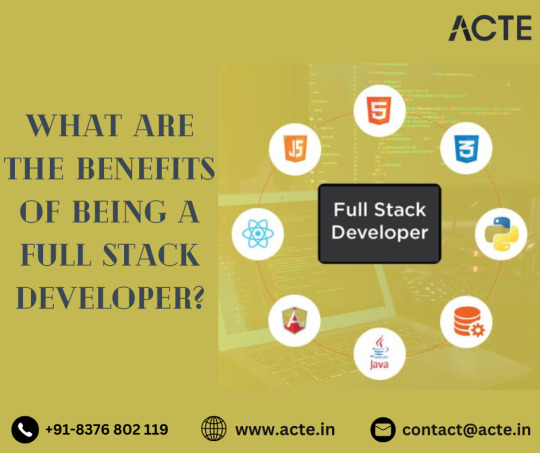
Unlocking the Benefits of Full Stack Development:
Versatility and Adaptability: Full stack developers possess a diverse skill set, encompassing proficiency in both front-end and back-end technologies. This versatility enables them to fluidly transition between different aspects of development, adeptly adapting to project requirements and challenges.Mastery of client-side and server-side technologies empowers full stack developers to tackle a myriad of tasks, from crafting intuitive user interfaces to implementing complex business logic. This adaptability renders them invaluable assets to development teams, capable of contributing to various stages of the software development lifecycle with finesse.
Comprehensive Project Ownership: A defining advantage of full stack developers lies in their ability to assume end-to-end ownership of projects, from inception to deployment. With a comprehensive understanding of both front-end and back-end technologies, full stack developers can oversee all facets of development, ensuring seamless integration and coherence throughout the project lifecycle.This holistic perspective empowers full stack developers to make informed decisions at every juncture of development, from conceptualization and architecture to execution and optimization. By embracing responsibility for the entire project, full stack developers drive efficiency, consistency, and quality, culminating in successful project outcomes.
Expanded Employability and Career Prospects: Full stack developers are highly coveted by employers owing to their diverse skill set and capacity to work across multiple technologies. Proficiency in both front-end and back-end technologies opens the door to a plethora of career opportunities across various industries and sectors.Employers prize full stack developers for their adaptability, versatility, and ability to deliver end-to-end solutions that align with business objectives. Whether it entails developing web applications, mobile apps, or enterprise software, full stack developers are poised to excel in diverse roles and environments, making them sought-after candidates in the job market.
Efficient Collaboration and Communication: Full stack developers excel in cross-functional collaboration, proficiently communicating with designers, product managers, and fellow developers alike. Their grasp of both front-end and back-end technologies bridges the gap between different teams and departments, fostering smoother communication and collaboration.This collaborative prowess enables full stack developers to seamlessly integrate with cross-functional teams, ensuring that project requirements are comprehended, feedback is incorporated, and deliverables are met punctually and within budget constraints. By fostering a culture of collaboration and synergy, full stack developers contribute significantly to project success and organizational growth.
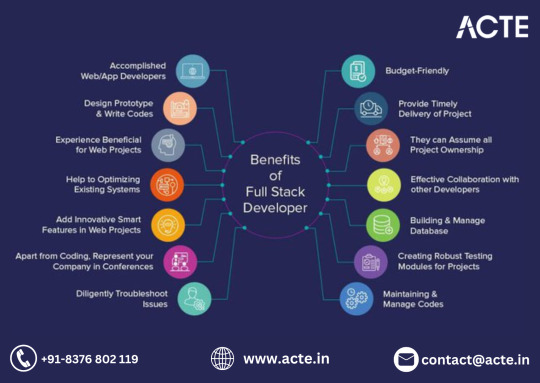
Agile Prototyping and Iteration: Full stack developers possess a knack for rapid prototyping and iteration, leveraging their comprehensive understanding of both front-end and back-end technologies. This proficiency enables them to swiftly prototype and iterate on features, accelerating development cycles and fostering innovation.By gathering feedback iteratively and swiftly incorporating user input and stakeholder feedback, full stack developers expedite the development process. This agile approach allows them to identify and address issues promptly, resulting in faster development cycles and heightened product quality.
Holistic Problem-Solving Proficiency: Full stack developers boast holistic problem-solving skills, enabling them to tackle challenges across the user interface and server layers. With an in-depth comprehension of both front-end and back-end technologies, full stack developers approach problems from diverse angles, exploring a plethora of solutions and technologies to pinpoint the most effective remedy.This comprehensive problem-solving approach fosters creativity, innovation, and critical thinking, as full stack developers explore various methodologies and techniques to resolve intricate problems. By harnessing their diverse skill set and experience, full stack developers surmount obstacles and deliver innovative solutions that cater to user needs and business imperatives.
Continuous Learning and Professional Growth: Full stack development is an ever-evolving domain that encourages continuous learning and professional growth. With new technologies, frameworks, and best practices perpetually emerging, full stack developers have ample opportunities to augment their skill set and remain abreast of industry trends.Continuous learning is inherent to the full stack developer role, necessitating a commitment to staying abreast of the latest advancements in both front-end and back-end technologies. By investing in continuous learning and professional development, full stack developers remain competitive in the job market and position themselves for sustained success in their careers.
Conclusion: In summary, embracing full stack development bestows a myriad of advantages and opportunities, ranging from versatility and end-to-end project ownership to enhanced employability and continuous learning. By mastering both front-end and back-end technologies, full stack developers are primed to excel in diverse roles and environments, driving innovation and success in the ever-evolving sphere of software development. Whether you're an established developer or an aspiring professional, embracing full stack development opens doors to a world of possibilities and professional fulfillment.
#full stack course#full stack developer#full stack software developer#full stack training#full stack web development
4 notes
·
View notes
Text
Top Frontend Development Tools to Use in 2023
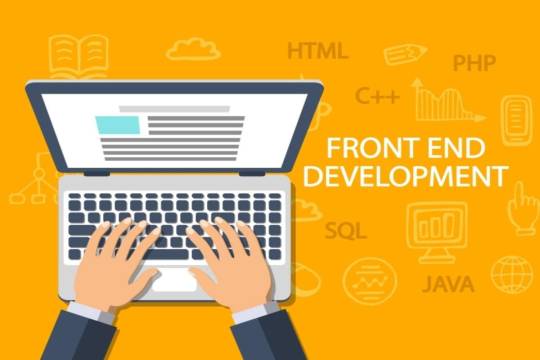
Front-End Web Development is a rapidly evolving field, with new tools and technologies constantly emerging. As we step into the year 2023, front-end developers are facing new challenges and opportunities in crafting engaging and responsive user interfaces. To stay ahead in this dynamic landscape, it's crucial to arm yourself with the right Frontend Development Tool.
In this blog, we will explore the top front-end development tools that are expected to dominate the industry in 2023. From code editors and frameworks to design tools and performance optimization, these tools will help you streamline your workflow, enhance productivity, and create cutting-edge web applications that meet the demands of modern users. Let's dive into the exciting world of front-end development and discover the must-have tools for 2023!
Top Frontend Development Tools to Use in 2023:
ReactJS:
ReactJS is a popular JavaScript library used by any Frontend Development Company for building user interfaces. With its component-based architecture, React allows developers to create reusable UI components that can be easily combined to build complex web applications.
React's virtual DOM (Document Object Model) enables efficient rendering, making it highly performant for creating interactive and dynamic user interfaces. React also has a large ecosystem of supporting tools, libraries, and community resources, making it a top choice for front-end development in 2023.
Vue.js:
Vue.js is another powerful JavaScript framework for building user interfaces. Known for its simplicity and ease of integration, Vue.js offers a flexible and scalable approach to front-end development. Vue.js follows a component-based architecture similar to React, making it highly modular and easy to understand.
Vue.js also offers features like two-way data binding, computed properties, and a comprehensive template syntax that simplifies the development process. With its growing popularity and extensive documentation, Vue.js is expected to gain more traction with any Web Development Company in 2023.
Figma:
Figma is a popular design tool that has gained significant popularity in recent years. It offers a collaborative and cloud-based approach to design, allowing front-end developers to work seamlessly with designers.
Figma offers powerful design and prototyping features, such as vector editing, component libraries, and real-time collaboration, making it a go-to tool for designing modern and responsive user interfaces. Figma also offers integrations with other design and development tools, making it a versatile choice for front-end developers in 2023.
Visual Studio Code:
Visual Studio Code (VSCode) is a widely used code editor that has become a staple in the front-end development community. With its extensive plugin ecosystem, powerful debugging capabilities, and rich set of features, VSCode provides an efficient and productive environment for writing front-end code.
VSCode offers support for a wide range of programming languages, including JavaScript, HTML, CSS, and popular front-end frameworks, making it a top choice for front-end developers in 2023.
Performance Optimization Tools:
As web applications become more complex, optimizing performance has become a crucial aspect of front-end development. Tools like Lighthouse, Webpage Test, and Google Page Speed Insights help developers analyze and optimize the performance of their web applications.
These tools offer insights and recommendations for improving areas like load times, caching, image optimization, and accessibility, helping developers create blazing-fast and user-friendly web applications in 2023.
jQuery:
jQuery is a widely used JavaScript library that has been a popular front-end development tool for many years. It provides a simplified way to interact with HTML documents, manipulate DOM elements, handle events, and make AJAX requests. jQuery offers a concise syntax and cross-browser compatibility, making it easy for developers to write efficient and interactive front-end code.
One of the key advantages of using jQuery is its simplicity and ease of use. It provides a concise and intuitive syntax that allows developers to perform common tasks, such as traversing the DOM, manipulating elements, and handling events, with just a few lines of code. This can significantly reduce the amount of code needed and simplify the development process.
Git and Version Control Tools:
Version control is an essential aspect of modern front-end development, allowing developers to collaborate, track changes, and revert to previous versions of their code.
Git, along with platforms like GitHub and GitLab, offers powerful version control capabilities, making it easy to manage the codebase, collaborate with teammates, and deploy changes to production. These tools are expected to continue to be a critical part of front-end development workflows in 2023.
CSS Pre-processors:
CSS pre-processors like Sass, Less, and Stylus have become popular tools for writing efficient and maintainable CSS code. These pre-processors offer features like variables, mixins, and nested selectors, making it easier to manage and organize CSS code for large web applications.
Conclusion:
The top front-end development tools for 2023 are expected to provide developers with powerful features that enhance their productivity, streamline their workflow, and enable them to create modern, responsive, and high-performing user interfaces.
These tools will be invaluable for Frontend Development Company India and Frontend developers in keeping up with the evolving landscape of web development. If you are looking for a Frontend Development Company in India, then connect with us now.
3 notes
·
View notes